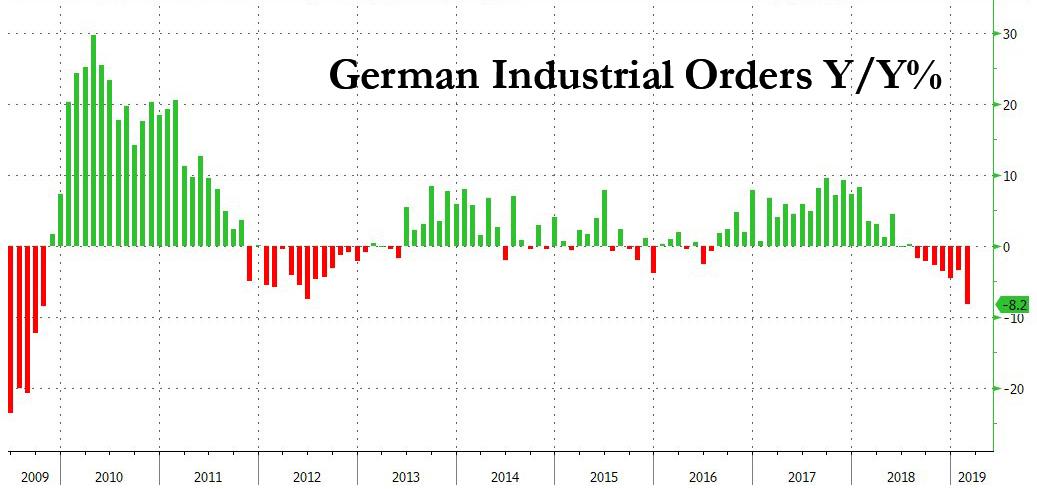One day after Germany’s leading economic institutes slashed their forecasts for 2019 growth by more than half on Thursday (and warned that the economy could slow much more if Britain quits the European Union without an agreement), Germany again confirmed just how bad the manufacturing recession at the heart of the Eurozone is, when it reported that Industrial orders fell by the biggest margin sequentially in more than two years in February, slumping 4.2%, badly missing consensus expectations of a 0.3% rebound, and worse than last monght’s -2.1% drop, highlighting the extent of the slowdown amid ongoing global trade disputes.
On an annual basis, the collapse was almost unprecedented, with the 8.2% drop matching the worst since the global financial crisis.
The drop in orders in February was marked by a slump in foreign demand, data from the Economy Ministry showed. Across sectors, orders of capital goods fell by 6.0%, compared with a decrease of 0.9% and 3.5% for intermediate and consumer goods orders, respectively.
As Goldman recaps, the February weakness was “broad-based across regions and sectors. Foreign orders declined the most (by 7.9%mom, of which -2.9% from the Euro area countries) against a decrease of 1.6% for domestic orders.”
Digging between the numbers, the IIF’s Robin Brooks noted that contrary to consensus, it wasn’t collapsing Chinese trade that was the culprit for the drop, but rather the GDP contraction in Turkey that disproportionately hit German manufacturing: while German exports to Turkey are only 1.4% of total, they were down 22% in the year to Jan. 2019.
German manufacturing has been disproportionately hit by the GDP contraction in Turkey. German exports to Turkey are only 1.4% of the total, but are down 22% in the year to Jan. 2019. So this is very idiosyncratic and not a reflection of global demand! Fade… pic.twitter.com/sNc3E2yZTw
— Robin Brooks (@RobinBrooksIIF) April 4, 2019
Long the Eurozone’s economic powerhouse, Germany barely avoided a technical recession at the end of last year and posted its weakest growth in five years in 2018 as its export-orientated economy is slowed by the trade and Brexit headwinds.
As Reuters notes, Germany’s slower-than-previously-expected growth means Finance Minister Olaf Scholz’s fiscal room for maneuver is getting tighter as tax revenues are likely to come in lower than expected this year. Last month, the cabinet passed a draft budget for 2020 that calls for a 1.7% spending increase and relies on ministries to cut costs to avoid incurring new debt in light of the slowdown.
The tighter public finances – after years of budget surpluses routinely exceeding expectations – are starting to raise tensions over spending priorities in Merkel’s awkward grand coalition, senior party officials say. Defense Minister Ursula von der Leyen said last month the ministry would have to fight next year to ensure that defense spending continues to expand as a share of the overall economy to move toward the NATO target of 2 percent of economic output.
Meanwhile as we noted yesterday, the German institutes’ forecasts were completed by March 29, the date Britain was originally due to leave the EU, when the institutes assumed it would not quit without an agreement on the terms. The deadline has since been extended to April 12. Their estimates feed into the government’s own growth projections, which will be updated later this month. In January, the government forecast growth of 1.0 percent for this year.
Economy Minister Peter Altmaier said the slowdown in Germany seen in the second half of 2018 would be overcome during the course of this year and replaced by an economic upswing. Still, officials are hopeful that once global trade disputes and Brexit are resolved, growth can pick up next year.
Summarizing all of the above, ING economist Carsten Brzeski said that “awful new-order data suggests that German industry is still suffering from Brexit woes and global uncertainties.”
via ZeroHedge News https://ift.tt/2OOMMVL Tyler Durden
